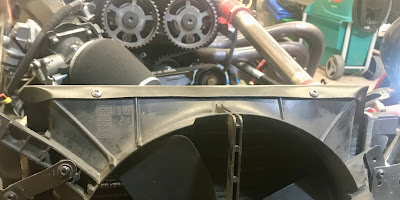Wednesday 14 October 2020
Does she go?
Monday 5 October 2020
Cooling fan manual and backup stat overrides
A little enhancement on the main engine cooling fan control.
While the ECU fan management is rock solid it is at the mercy of input sensors.
It is straightforward to add a manual switch into the fan relay coil as an override. If my temp sensor ever goes bad again the switch under the dash will let me manually turn on the engine fan.
To make things more interesting I incorporated a tri-colour LED to show on the dash when the fan is on, it sits unobtrusively bottom right of the water temp gauge.
Off = fan is off
Green = fan on via ECU demand
Red (ish) = fan on via Manual dash switch demand (its actually red + green but the red is more intense)
Blue = fan on via Radiator stat demand
I have a VW Polo radiator with a mounting point for a simple temp sensor which closes a switch, and for me, grounds the cable when it hits a temp limit. This is the automatic backup if the ECU sensor fails again & will light blue on the dash as a warning.
Circuit
Emerald Pin 6
Sunday 4 October 2020
Indicator tell-tale
The dash was off for other works and I managed to find a green, rather than the old blue, tell-tale for the 'in my face' left-right direction indicator bulb between the main clocks - thats better.
Saturday 1 August 2020
Taxed
Sunday 31 May 2020
Loose ends
Monday 25 May 2020
She lives!
- Aux belt tensioner bracket
- Aux belt
Addendum
All good disassembly/assembly projects should end up with a few extra parts - this one is entirely intentional. I couldn't remove it without cutting the connector off because of the alternator bracket. It isn't generally connected or used on a Zero/Emerald combination - although if it is a thermostat the emerald does support multiple temp inputs?
Not needed and no longer fitted.
Timing
I didn't change the cam belt this time - its good for another 5 years & best part of 80k miles before it needs doing again.
1. Crank vs. cam position
2. Crank vs. cam sprocket position
3. Sprockets locked to camshafts
Then the cam sprockets are tightened locking them to the camshafts. The camshaft plate at the back is removed for tightening and replaced once done as a double check. The engine then turned by hand one cycle, two rotations and tensions/alignments double checked.That should be it - timing set.
Sunday 24 May 2020
Head on
Tools
More Cleaning
Head on
Thursday 21 May 2020
Head cleanup and measure
Is it flat... enough?
Prep
Measurement errors
Measure method #1
Measure method #2
Result
Friday 15 May 2020
Head off
Why am I doing this
The failure I believe is due to overheat caused by a failing temp sensor and lack of fan cooling when the car was stationary. i.e. I believe I have identified the root cause before this attempted fix.Disconnecting ancillaries
Cam shafts and followers
Head
Block
First stage done.
The bigger challenge is can I put it back together and get it operational?
Worst case this will become an engine rebuild job for an engineering firm.
Update - Received knowledge (thank you) - WD40 is less than ideal for this job - it cleans, but it also strips any other lubricant or surface coating which can induce surface rust. I've since cleaned up and made sure the parts that matter have an engine oil soak/coating to ensure lubrication is maintained.

















































